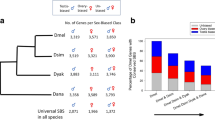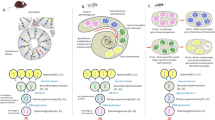Abstract
The possible association between gonadal protein divergence and postzygotic reproductive isolation was investigated among species of the Drosophila melanogaster and D. virilis groups. Protein divergence was scored by high-resolution two-dimensional electrophoresis (2DE). Close to 500 protein spots from gonadal tissues (testis and ovary) and nongonadal tissues (malpighian tubules and brain) were analyzed and protein divergence was calculated based on presence vs absence. Both testis and ovary proteins showed higher divergence than nongonadal proteins, and also a highly significant positive correlation with postzygotic reproductive isolation but a weaker correlation with prezygotic reproductive isolation. Particularly, a positive and significant correlation was found between proteins expressed in the testis and postzygotic reproductive isolation among closely related species such as the within-phylad species in the D. virilis group. The high levels of male-reproductive-tract protein divergence between species might be associated with F1 hybrid male sterility among closely related species. If so, a lower level of ovary protein divergence should be expected on the basis that F1 female hybrids are fully fertile. However, this is not necessarily true if relatively few genes are responsible for the reproductive isolation observed between closely related species, as recent studies seem to suggest. We suggest that the faster rate of evolution of gonadal proteins in comparison to nongonadal proteins and the association of that rate with postzygotic reproductive isolation may be the result of episodic and/or sexual selection on male and female molecular traits.
Similar content being viewed by others
References
Aguade M, Miyashita N, Langley CH (1992) Polymorphism and divergence in the Mst26A male accessory gland gene region in Drosophila. Genetics 132:755–770
Ayala FJ (1975) Genetic differentiation during the speciation process. Evol Biol 8:1–78
Boswell RE, Mahowald AP (1985) tudor, a gene required for assembly of the germ plasm in Drosophila melanogaster. Cell 43:97–104
Britten RJ (1986) Rates of DNA sequence evolution differ between taxonomic groups. Science 231:1393–1398
Carson HL (1975) The genetics of speciation at the diploid level. Am Nat 109:83–92
Carson HL (1982) Speciation as a major reorganization of polygenic balances. In: Barigozzi C (ed) Mechanisms of speciation. Liss, New York, pp 421–433
Cheney CM, Shearn A (1983) Developmental regulation of Drosophila imaginal disc proteins: synthesis of heat shock protein under nonheat-shock conditions. Dev Biol 95:325–330
Choudhary M, Singh RS (1987) Historical effective size and the level of genetic diversity in Drosophila melanogaster and Drosophila pseudoobscura. Biochem Genet 25:41–51
Clark AG, Aguade M, Prout T, Harshman LG, Langley CH (1995) Variation in sperm displacement and its association with accessory gland protein loci in Drosophila melanogaster. Genetics 139:189–201
Coulthart MB (1986) Variation and evolution in proteins of the Drosophila male reproductive tract. PhD thesis, McMaster University, Hanilton, Ontario, Canada
Coulthart MB, Singh RS (1988a) Low genic variation in male-reproductive-tract proteins of Drosophila melanogaster and D. simulans. Mol Biol Evol 5:167–181
Coulthart MB, Singh RS (1988b) High level of divergence of male-reproductive-tract proteins, between Drosophila melanogaster and its sibling species, D. simulans. Mol Biol Evol 5:182–191
Coulthart MB, Singh RS (1988c) Differing amounts of genetic polymorphism in testes and male accessory glands of Drosophila melanogaster and Drosophila simulans. Biochem Genet 26:153–164
Coyne JA (1985) Genetic studies of three sibling species of Drosophila with relationship to theories of speciation. Genet Res 46:169–192
Coyne JA (1992) Genetics and speciation. Nature 355:511–515
Coyne JA, Orr AH (1989) Patterns of speciation in Drosophila. Evolution 43:362–381
Dobzhansky Th, Beadle GW (1936) Studies on hybrid sterility. IV. Transplanted testes in Drosophila pseudoobscura. Genetics 21: 832–840
Eberhard WG (1985) Sexual selection and animal genitalia. Harvard University Press, Cambridge, MA, pp 1–18, 30–33, 181–188
Gillespie JH (1984) The molecular clock may be an episodic clock. Proc Natl Acad Sci USA 81:8009–8013
Harris HD, Hopkinson A, Edwards YH (1977) Polymorphism and the subunit structure of enzymes: A contribution to the neutralist-selectionist controversy. Proc Natl Acad Sci USA 74:698–701
Hochstrasser DF, Harrington MG, Hochstrasser A-C, Miller MJ, Merril CR (1988) Methods for increasing the resolution of two-dimensional protein electrophoresis. Anal Biochem 173:424–435
Hubby JL, Throckmorton LH (1965) Protein differences in Drosophila. II. Comparative species genetics and evolutionary problems. Genetics 52:203–215
Joly D, Bressac C, Devaux J, Lachaise D (1991) Sperm length diversity in Drosophilidae. DIS 70:104–108
Kalb JM, Dibenedetto AJ, Wolfner MF (1993) Probing the function of Drosophila melanogaster accessory glands by directed cell ablation. Proc Natl Acad Sci USA 90:8093–8097
Kimura M (1968) Evolutionary rate at the molecular level. Nature 217:624–626
Kimura M (1969) The rate of molecular evolution considered from the sandpoint of population genetics. Proc Natl Acad Sci USA 63: 1181–1188
King MC, Wilson AC (1975) Evolution at two levels. Molecular similarities and biological differences between humans and chimpanzees. Science 188:107–116
Kuhn R, Kuhn C, Borsch D, Glatzer KH, Schafer U, Schafer M (1991) A cluster of four genes selectively expressed in the male germ line of Drosophila melanogaster. Mech Dev 35:143–151
Lachaise D, Cariou M-L, David JR, Lemeunier F, Tsacas L, Ashburner M (1988) Historical biogeography of the Drosophila melanogaster species subgroup. Evol Biol 22:159–225
Lewontin RC (1974) The genetic basis of evolutionary change. Columbia University Press, New York, pp 167–179
Mahowald AP, Kambysellis MP (1980) Oogenesis. In: Ashburner M, Wright TRF (eds) The genetics and biology of drosophila, vol 2d. Academic Press, London, pp 141–224
Marshal SA (1983) The genus Bromeloecia Spuler in North America (Diptera: Sphaeroceridae: Limosininae). Proc Entomol Sue Wash 85:32–35
Mayr E (1963) Animal species and evolution. Harvard University Press, Cambridge, MA, pp 538–541, 615
Merril CR, Donau ML, Goldman D (1981) A rapid sensitive silver stain for polypeptides in polyacrylamide gels. Anal Biochem 110:201–207
Morrisey JH (1982) Silver stain for proteins in polyacrylamide gels: a modified procedure with enhanced uniform sensitivity. Anal Biochem 178:307–310
Nei M (1972) Genetic distances between populations. Am Nat 106: 283–292
Palumbi SR (1989) Rates of molecular evolution and the fraction of nucleotide positions free to vary. J Mol Evol 29:180–187
Perez DE, Wu C-I, Johnson NA, Wu M-L (1993) Genetics of reproductive isolation in the Drosophila simulans clade: DNA marker-assisted mapping and characterization of a hybrid-male sterility gene, Odysseus (Ods). Genetics 133:261–275
Pitnick S, Markow TA (1994) Male gametic strategies: sperm size, testes size, and the allocation of ejaculate among successive mates by the sperm-limited fly Drosophila pachea and its relatives. Am Nat 143:785–819
Powell JR, Caccone A, Amato GD, Yoon C (1986) Rates of nucleotide substitution in Drosophila mitochondrial DNA and nuclear DNA are similar. Proc Natl Acad Sci USA 83:9090–9093
Reinhold SL, Collier GE (1990) Molecular systematics of the Drosophila virilis species group (Diptera: Drosophilidae). Ann Entomol Soc Am 83:467–474
Schafer M, Kuhn R, Bosse F, Schafer U (1990) A conserved element in the leader mediates post-meiotic translation as well as cytoplasmic polyadenylation of Drosophila spermatocyte mRNA. EMBO J 9:4519–4525
Selander RK, Johnson WE (1973) Genetic variation among vertebrate species. Annu Rev Ecol Syst 4:75–91
Singh RS (1990) Patterns of species divergence and genetic theories of speciation. In: Wohrmann K, Jain SK (eds) Population biology. Springer-Verlag, Berlin, pp 231–265
Singh RS, Coulthart MB (1982) Genic variation in abundant soluble proteins of Drosophila melanogaster and Drosophila pseudoobscura. Genetics 102:437–453
Singh RS, Rhomberg L (1987) A comprehensive study of genic variation in natural populations of Drosophila melanogaster. II. Estimates of heterozygosity and patterns of geographic differentiation. Genetics 117:255–271
Sneath PHA, Sokal RR (1973) Numerical taxonomy. WH Freeman, San Francisco, pp 131, 573
Sokal RR, Sneath PHA (1963) Principles of numerical taxonomy. WH Freeman, San Francisco, p 359
Spicer GS (1991) Molecular evolution and phylogeny of the Drosophila virilis species group as inferred by two-dimensional electrophoresis. J Mol Evol 33:379–394
Spicer GS (1992) Reevaluation of the phylogeny of Drosophila virilis species group (Diptera: Drosophilidae) Ann Entomol Soc Am 85: 11–25
Spieth HT (1979) The virilis group of Drosophila and the beaver Castor. Am Nat 114:312–316
Templeton AR (1980) The theory of speciation via the founder principle. Genetics 94:1011–1038
Templeton AR (1981) Mechanisms of speciation—a population genetics approach. Ann Rev Ecol Syst 12:23–48
Thomas S, Singh RS (1992) A comprehensive study of genic variation in natural populations of Drosophila melanogaster. VII. Varying rates of genic divergence as revealed by two-dimensional electrophoresis. Mol Biol Evol 9:507–525
Throckmorton LH (1977) Drosophila systematics and biochemical evolution. Ann Rev Ecol Syst 8:235–254
Throckmorton LH (1982) The virilis species group. In: Ashburner M, Carson HL, Thompson Jr JN (eds) The genetics and biology of Drosophila, vol 3b. Academic Press, London, pp 227–296
Veuille M, Lepesant JA, Yanicostas C (1994) Unusually high rate of molecular evolution in Janus. In:35th Annual Drosophila Research Conference. Program and Abstracts Volume, Chicago, p 353
Wessing A, Eichelberg D (1978) Malpighian tubules, rectal papillae and excretion. In: Ashbumer M, Wright TRF (eds) The genetics and biology of Drosophila, vol 2c. Academic Press, London, pp 1–42
Wu C-I, Perez DE, Davis AW, Johnson NA, Cabot EL, Palopoli MF, Wu M-L (1993) Molecular genetic studies of postmating isolation in Drosophila. In: Takahata N, Clark AG (eds) Molecular mechanisms of evolution. Sinauer, Sunderland, MA, pp 191–212
Yanicostas C, Vincent A, Lepesant J-A (1989) Transcriptional and posttranscriptional regulation contributes to the sex-regulated expression of two sequence-related genes at the janus locus of Drosophila melanogaster. Mol Cell Biol 9:2526–2535
Zeng L-W, Singh RS (1993a) A combined classical genetic and high resolution two-dimensional electrophoresis approach to the assessment of the number of genes affecting hybrid male sterility in Drosophila simulans and Drosophila sechellia. Genetics 135:135–147
Zeng L-W, Singh RS (1993b) The genetic basis of Haldane's rule and the nature of asymmetric hybrid male sterility among Drosophila simulans, Drosophila mouritiana and Drosophila sechellia. Genetics 134:251–260
Author information
Authors and Affiliations
Additional information
Correspondence to: A. Civetta
Rights and permissions
About this article
Cite this article
Civetta, A., Singh, R.S. High divergence of reproductive tract proteins and their association with postzygotic reproductive isolation in Drosophila melanogaster and Drosophila virilis group species. J Mol Evol 41, 1085–1095 (1995). https://doi.org/10.1007/BF00173190
Received:
Accepted:
Issue Date:
DOI: https://doi.org/10.1007/BF00173190




